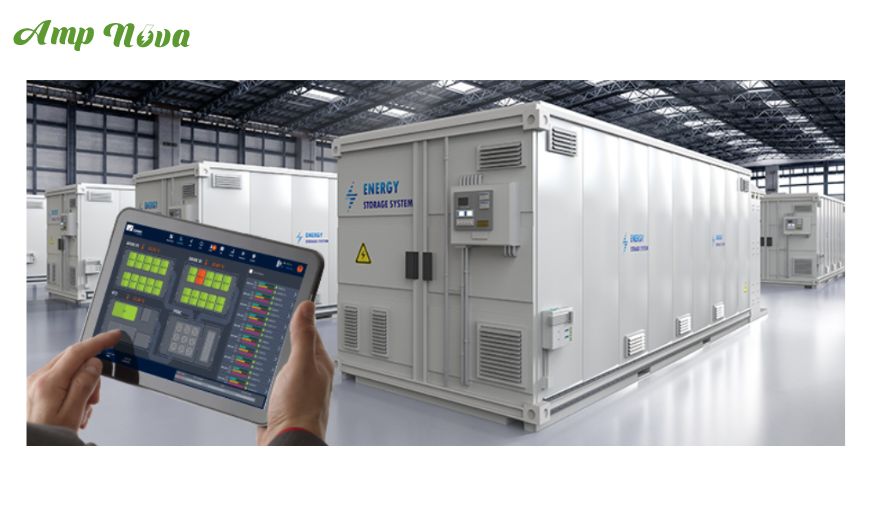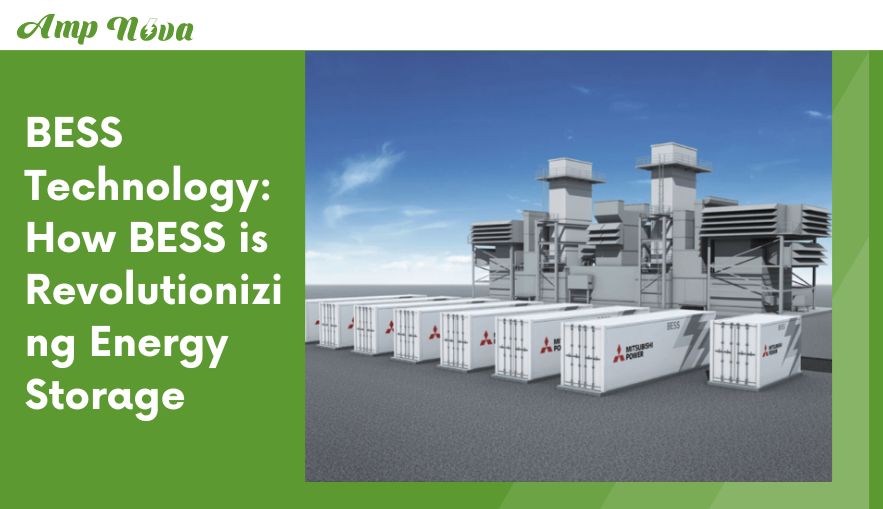BESS Technology: At Amp Nova, we are at the forefront of pioneering Battery Energy Storage System (BESS) technology, a transformative solution for modern energy challenges.
Our cutting-edge BESS Technology solutions are designed to enhance grid stability, support the integration of renewable energy sources, and provide reliable backup power for various applications.
Our advanced lithium battery solutions under the “Amp Nova” brand are optimized for efficiency, safety, and sustainability.
They are essential in smoothing intermittent renewable generation, shifting energy to peak demand periods, and enhancing the reliability of microgrids and islanded systems.
Related post
The Top Solar Battery Producers: A Comprehensive Guide 2024
The Solar Battery Manufacturer Unleashing the Power of BEES Energy Storage!
Contents
Components of BESS
Battery Technologies
Types of Batteries Used in BESS
- Lithium-Ion Batteries: Known for their high energy density, long cycle life, and efficiency, lithium-ion batteries are widely used in various BESS applications, from residential to utility-scale systems.
- Flow Batteries: These batteries, such as vanadium redox flow batteries, are valued for their scalable energy capacity and are ideal for long-duration storage and frequent cycling.
- Lead-Acid Batteries: Despite being an older technology, lead-acid batteries remain in use for specific BESS applications due to their reliability and lower initial cost.

Characteristics and Advantages of Each Battery Type
Lithium-Ion Batteries:
High Energy Density: Stores more energy in a compact form.
Long Cycle Life: Durable with many charge-discharge cycles before significant performance drop.
Efficiency: High round-trip efficiency, reducing energy loss during storage and use.
Flow Batteries:
- Lead-Acid Batteries:
- Cost-Effective: Lower upfront costs.
- Proven Reliability: Long-standing use and trusted performance.
- High Power Output: Capable of delivering high surge currents for short periods.
- Scalability: Easily increase energy capacity by adding more electrolyte solution.
- Durability: Long lifespan with minimal degradation.
- Safety: Reduced risk of thermal runaway compared to lithium-ion batteries.
B. Inverter Systems
Role of Inverters in BESS
- AC-DC Conversion: Convert the direct current (DC) stored in batteries to alternating current (AC) for use in various applications.
- Grid Interaction: Manage the flow of electricity between the battery, load, and grid, ensuring efficient distribution and stability.
- Control and Monitoring: Monitor system performance, protect against faults, and ensure safe operation.
https://www.innoliaenergy.com/wp-content/uploads/2020/07/bess.png
Types of Inverters
- Bidirectional Inverters: Can convert DC to AC and AC to DC, facilitating seamless integration with the grid and renewable energy sources.
- Grid-Tied Inverters: Work in conjunction with the grid, allowing for the export of excess energy back to the grid and import when needed, enhancing system efficiency and reliability.
C. Energy Management System (EMS)
Functionality and Importance of EMS in BESS Technology
- System Control: Oversees the operation of the entire BESS, including charging, discharging, and managing energy flows.
- Optimization: Balances energy supply and demand, maintains battery health, and maximizes efficiency.
- Integration: Facilitates the integration of renewable energy sources and coordinates with grid requirements for services like frequency regulation and peak shaving.

Optimization of Battery Performance and Grid Interaction
- Smart Algorithms: Use advanced algorithms to predict energy usage patterns and optimize battery operations.
- Real-Time Monitoring: Continuously monitors battery status, energy flows, and grid conditions, allowing dynamic adjustments for reliable performance.
- Enhanced Reliability: Optimizes energy storage and distribution to improve grid stability and resilience, supporting a sustainable energy infrastructure.
Applications of BESS Technology
Grid Support and Stability
- Frequency Regulation:
- BESS helps maintain the balance between electricity supply and demand by responding quickly to frequency fluctuations. This ensures a stable and reliable power grid, preventing blackouts and maintaining consistent power quality.
- Voltage Control:
- BESS can provide voltage support by injecting or absorbing reactive power, helping to stabilize voltage levels on the grid. This is crucial for maintaining the integrity of the power system and ensuring the efficient operation of electrical equipment.
Renewable Integration
- Smoothing Intermittent Renewable Generation:
- BESS mitigates the variability of renewable energy sources like solar and wind by storing excess energy generated during peak production times and releasing it during periods of low generation. This smooths out the fluctuations and provides a more consistent power supply.
- Shifting Renewable Energy to Peak Demand Periods:
- By storing surplus renewable energy and discharging it during times of high demand, BESS helps align energy supply with consumption patterns. This reduces reliance on fossil fuels during peak periods and maximizes the use of clean energy.
Microgrid and Islanded Systems
- Providing Backup Power:
- BESS ensures a reliable power supply in microgrids and islanded systems by providing backup power during grid outages or disruptions. This enhances energy security and continuity for critical applications and remote areas.
- Enhancing Resilience and Reliability:
- BESS enhances resilience in microgrids and isolated systems by supporting autonomous operation and maintaining power stability during grid disturbances. This capability is vital for communities and facilities that require uninterrupted power supply.
These applications demonstrate BESS’s versatility and critical role in modernizing and stabilizing the energy infrastructure, promoting the integration of renewable energy, and enhancing the resilience of power systems.
Benefits of BESS Technology
A. Enhanced Grid Reliability
- Mitigating Grid Disturbances and Blackouts:
- BESS provides a rapid response to grid disturbances by supplying or absorbing power as needed, helping to prevent blackouts and ensure a stable and reliable power supply. This capability is essential for maintaining the continuous operation of the grid, especially during unexpected events or sudden changes in demand.
- Improving Power Quality:
- By stabilizing voltage levels and providing frequency regulation, BESS enhances the overall quality of power delivered to consumers. This leads to fewer interruptions and better performance of electrical equipment, contributing to a more reliable and efficient power system.
B. Economic Benefits
- Peak Shaving and Load Leveling:
- BESS reduces the need for expensive peak power plants by storing energy during periods of low demand and releasing it during peak times. This “peak shaving” lowers the overall cost of electricity and reduces strain on the grid, making energy consumption more efficient and cost-effective.
- Demand Charge Management:
- For businesses and industrial users, BESS helps manage and reduce demand charges by controlling the amount of power drawn from the grid during peak periods. This leads to significant cost savings on electricity bills and more predictable energy expenses.
C. Environmental Impact
- Reducing Greenhouse Gas Emissions:
- By facilitating the integration of renewable energy sources and reducing reliance on fossil fuel-based power generation, BESS significantly lowers greenhouse gas emissions. This contributes to cleaner air and helps combat climate change.
- Supporting Clean Energy Transitions:
- BESS enables a smoother transition to a sustainable energy future by enhancing the reliability and efficiency of renewable energy systems. By storing and distributing clean energy more effectively, BESS supports the broader adoption of renewable energy technologies and fosters a greener energy landscape.
These benefits highlight the crucial role of BESS in enhancing grid reliability, providing economic advantages, and supporting environmental sustainability, making it a key component in the future of energy systems.
Challenges and Considerations
A. Cost
- Initial Investment and Lifecycle Costs:
- The upfront cost of installing a Battery Energy Storage System (BESS) can be substantial, encompassing the price of batteries, inverters, control systems, and installation. Additionally, lifecycle costs, including maintenance, operation, and eventual replacement of batteries, can also be significant. These expenses can be a barrier to widespread adoption, particularly for smaller businesses or residential users.
- Cost Competitiveness with Other Energy Storage Technologies:
- BESS must compete with other energy storage solutions, such as pumped hydro storage, compressed air energy storage, and emerging technologies. Ensuring that BESS remains cost-competitive involves continuous innovation to reduce costs and improve performance, as well as achieving economies of scale in manufacturing and deployment.
B. Technical Challenges
- Battery Degradation and Aging:
- Over time, batteries experience degradation, which reduces their capacity and efficiency. Factors such as charge-discharge cycles, temperature variations, and usage patterns can accelerate aging. This necessitates ongoing research to develop batteries with longer lifespans and better resilience to degradation.
- Safety and Regulatory Considerations:
- Safety is paramount in BESS deployment, as batteries can pose risks of overheating, fire, and chemical leakage. Ensuring compliance with stringent safety standards and regulations is crucial. This includes implementing robust battery management systems, adhering to safety protocols, and meeting certifications such as UL1973, UN38.3, and IEC62133.
C. Market and Policy Considerations
- Regulatory Frameworks and Incentives:
- The successful integration of BESS into energy systems depends on supportive regulatory frameworks and incentives. Policies that promote renewable energy adoption, provide subsidies or tax incentives for energy storage, and establish clear guidelines for grid interconnection are essential to encourage investment in BESS technology.
- Market Integration and Business Models:
- Integrating BESS into existing energy markets requires the development of viable business models that address both technical and economic aspects. This includes creating markets for ancillary services, such as frequency regulation and demand response, and designing tariff structures that reward energy storage participation. Effective market integration ensures that BESS can deliver value to both grid operators and consumers.
Addressing these challenges and considerations is critical for the continued growth and success of BESS technology. By overcoming cost barriers, enhancing technical reliability, and fostering supportive market and policy environments, BESS can realize its full potential in transforming energy systems worldwide.
Future Trends and Innovations
A. Technological Advancements
- Improvements in Battery Chemistry and Performance:
- Continuous research and development are leading to significant improvements in battery chemistry, resulting in batteries with higher energy density, longer cycle life, and improved safety. Innovations such as solid-state batteries, which replace the liquid electrolyte with a solid material, offer the potential for safer and more efficient energy storage. Advancements in materials science are also contributing to the development of batteries that can operate in a wider range of temperatures and endure more charge-discharge cycles without significant degradation.
- Development of Next-Generation Storage Technologies:
- Beyond lithium-ion, several next-generation storage technologies are emerging. These include flow batteries, which offer scalable energy capacity and long cycle life, and metal-air batteries, which have the potential for extremely high energy densities. Other promising technologies include sodium-ion batteries, which could offer a more abundant and lower-cost alternative to lithium-ion, and advanced supercapacitors that provide rapid charge and discharge capabilities.
B. Expansion of Applications
Growth in Utility-Scale Deployments:
Utility-scale BESS deployments are expected to grow rapidly as grid operators seek to enhance grid stability and integrate larger shares of renewable energy.
These large-scale systems can provide essential services such as frequency regulation, peak shaving, and backup power, helping to balance supply and demand on the grid.
As costs continue to decline and performance improves, the scale and number of utility-scale BESS projects are likely to increase, contributing to a more resilient and flexible energy infrastructure.
Emerging Applications in Transportation and Industrial Sectors:
BESS technology is finding new applications beyond traditional energy storage. In the transportation sector, advanced batteries are being used to power electric vehicles (EVs) and support the development of electric fleets for public transportation, logistics, and delivery services.
In industrial sectors, BESS can provide reliable backup power, improve energy efficiency, and support microgrid applications, enhancing operational resilience and reducing energy costs.
Additionally, the use of BESS in commercial and residential buildings for demand charge management and renewable energy integration is expanding, driven by the growing focus on sustainability and energy independence.
These future trends and innovations in BESS technology highlight the ongoing evolution and broadening impact of energy storage solutions.
By continuing to advance battery technologies and expanding their applications across various sectors, BESS will play a crucial role in the transition to a cleaner, more efficient, and resilient energy future.
Conclusion of BESS Technology
Battery Energy Storage System (BESS) technology plays a pivotal role in the energy transition, offering essential solutions for enhancing grid reliability, supporting renewable energy integration, and providing backup power in critical applications.
Additionally, the expansion of BESS applications into utility-scale deployments, transportation, and industrial sectors will drive widespread adoption and integration.
As costs continue to decline and performance enhances, BESS technology is set to become increasingly cost-competitive and accessible.
In summary, BESS technology is essential for advancing the energy transition, with a bright future of continued innovation and broader adoption on the horizon.
